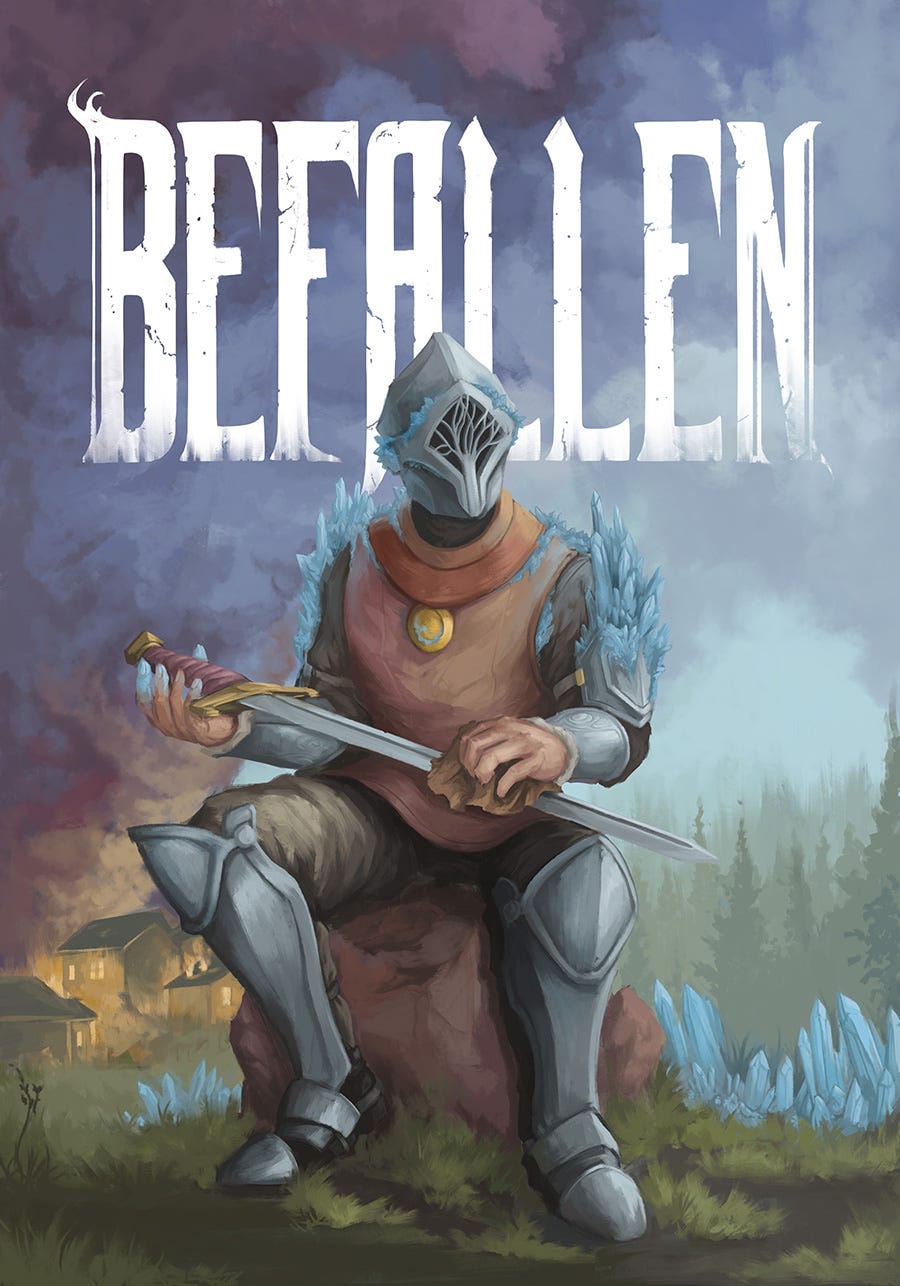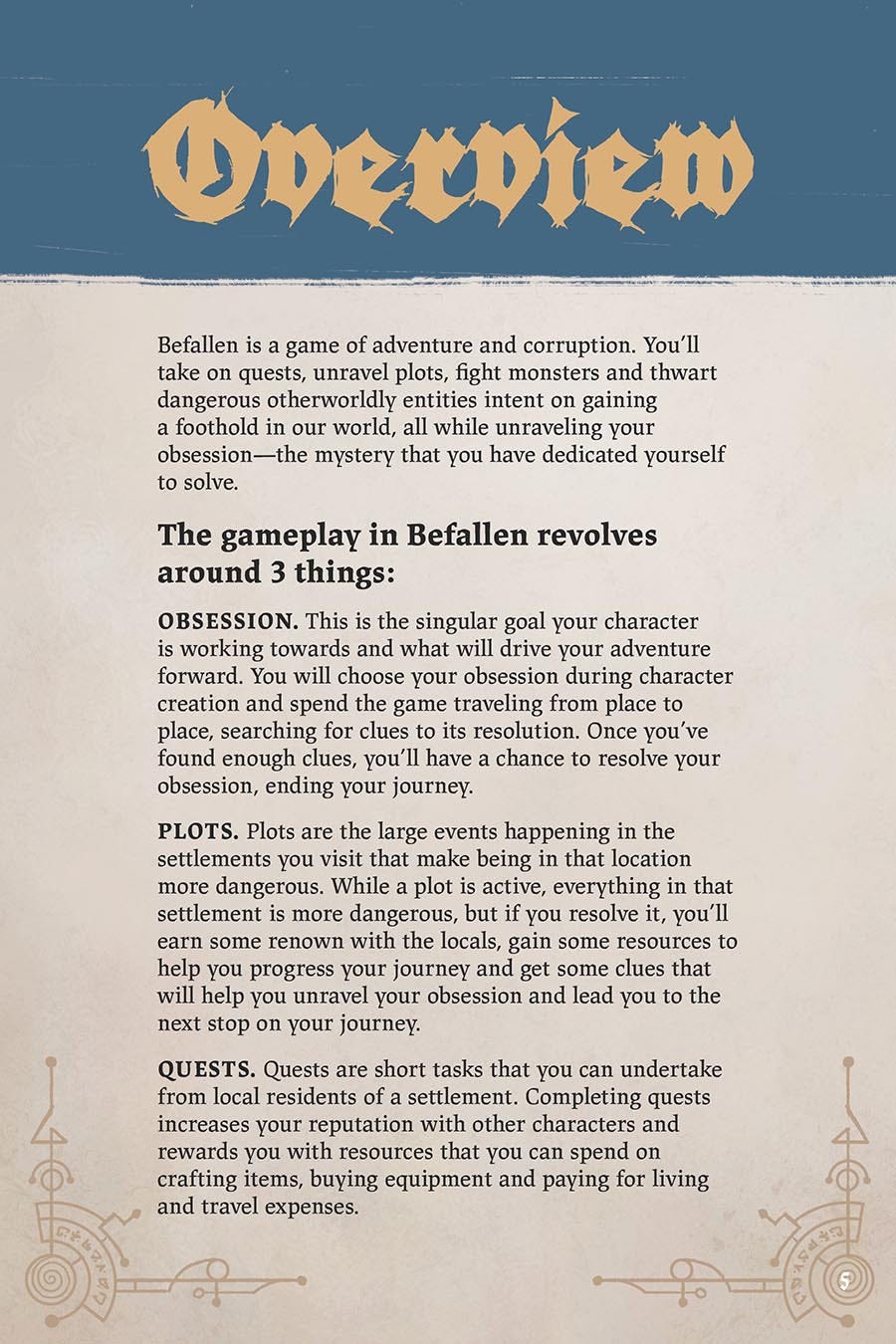Overview: Befallen by Utopia RPGs
Let's take a look at this dark fantasy TTRPG about obsession, corruption, and haunted characters.
I’ve written a playthrough of the game! Start reading here: The Ballad of Luigi Solare, part 1
Obsession, eldritch corruption, and haunted characters. The book had me at the cover and hooked me at the synopsis.
Befallen is a solo dark fantasy TTRPG written, illustrated, and published by David Markiwsky (Utopia RPGs). It can also be played as a group of 2-4 players, with or without a GM.
It revolves around characters with an obsession, the ultimate goal that drives them as they travel between settlements, unravel dangerous plots, fight monsters, and complete quests. They must also thwart and resist the Corrupting Powers—eldritch entities that offer abilities at a perilous cost—or be consumed by them.
Another core mechanic is the haunt, the thing that hinders your character and will provide a source to draw complications from.
The book has 11 character classes, each with suggestions for obsessions and haunts, but David also guides you on how to create your own.
Befallen is a story-driven game first, with satisfying mechanics for exploration and combat. I’m still new to the solo RPG genre, but the amount of crunch in the game is my favorite so far.
Skill rolls
Befallen uses a challenge die and a d10 to roll over it, augmented by skills, stamina, and knowledge. The challenge die is between a d8, d10, or d12, except for the Corruption mechanic, which uses a d6. The challenge may have a bonus due to the Peril mechanic.
You only need one roll over to succeed.
Let’s try an example. Say we’re trying to bribe a guard to allow me passage after curfew. If the guard doesn’t have a challenge roll in the book (a lot of NPCs and enemies have), there is a table to check.
The guard is tired and doesn’t care, so we decided the challenge is a d8. Our character has a point in the Persuasion skill. We are going to roll on it.
Challenge roll, d8 = 4
Persuasion roll, 2d10 (1 die is the base, +1 for having the skill) = 9, 3
One success, which means we managed to bribe him.
What if we failed the roll? We cannot try the same task again using the same skill on the same day.
So we’ll try instead to sneak past him, rolling with the Sneak skill. Our character doesn’t have a point in it, so we only get one die. However, we can spend 1 stamina point to get another. All characters have 5 stamina points that are recovered after resting.
The Peril mechanic is a measure of danger. Each active Peril adds +1 to the challenge rolls. It can be life-threatening situations, an active Plot in the settlement, rolls involving Corrupting powers, disadvantages, and exhaustion.
Combat and Confrontations
Battles work similarly to skill rolls. You choose an action, roll the enemy’s challenge die and try to roll over it. Most battle rolls with be with the Strike and Deft skills. On a success, you deal damage. On a fail, you take damage or roll on an enemy action table.
You can also engage in Confrontations, which follow the mechanics of a battle, but are meant for debates or arguments against an opponent.
This is a very light overview of the system. You and the enemies have special abilities and powers that add another layer of choices and reactions to encounters.
Fate and Complications
Rolling a 10 is always a success, regardless of the challenge roll, and we also gain 1 fate point.
Fate points represent the influence of the fates on your character’s life, and can be used to reroll a d10, add or reduce 1 damage during battle, or to gain 1 resource, the game’s currency.
Rolling a 1 always adds a complication to the narrative, regardless of success or failure, even if you reroll it.
Complications are unexpected events that add a problem for the character and must be overcome before proceeding. They shouldn’t influence the success or failure of the current task. The problem should be drawn from the context, but can also come from the character’s haunt or from a Corrupting power.
Let’s try to bribe that guard again.
Challenge roll, d8 = 4
Persuasion roll, 2d10 (1 die is the base, +1 for having the skill) = 10, 1
Success and we gain 1 fate point, but with a complication.
A few ideas are:
-The guard agrees, but asks for more money.
-Our character bumbled for the purse and scattered the coins on the ground, attracting other guards.
-The spirit haunting you laughs and scoffs at the guard. He thinks it was you and punches your face after taking the coin. You lose 1 Fortitude and 1d10 in rolls with that guard (if he’s a recurring NPC).
Corruption
The corrupting powers are supernatural forces gaining a foothold in the world and using mortal agents to enact their will.
Your corruption level indicates the extent of your corruption by a power and the number of corruption dice you have access to. Higher levels give you more dice and stronger abilities, but it brings your character closer to full corruption. At level 9, your character will forget their obsession and become a tool of that power.
Corruption dice are spent to fuel corruption abilities (which trigger a corruption roll on that day) or to turn a failure roll into a success (instantly increases your corruption).
If you interact with a corrupting power, you must make a roll at the end of the day to resist further corruption. The challenge die is a d6 + your current corruption, which makes resisting higher levels extremely difficult.
You can also make quests to either feed or oppose the corrupting powers. There are several suggestions in the book, but you can also create your own.
Settlements, Plots and Quests
Plots are large events happening in the settlements. They are complex quests that require several steps and skill rolls to solve. Think of it as the major adventure of a settlement. They begin with a mystery or rumor that you investigate and then set a path to resolve.
While a plot is active, everything in that settlement is more dangerous (+1 to challenge rolls), but if you resolve it, you’ll gain some renown, resources to help you progress your journey, and clues that will bring you closer to your obsession and lead you to the next stop on your journey.
Quests are short tasks from NPCs in a settlement. Completing quests increases your reputation with them and rewards you with resources that you can spend on crafting items, buying equipment and paying for living and travel expenses.
Befallen comes with 9 pre-generated settlements, each with 2-3 plots per settlement and tables with 6-10 quest hooks. The book also helps you to create your own settlements, plots, and quests.
Befallen has an emphasis on story, but the crunch is on point. Rolls are flexible and encourage narrative and creativity, especially with the complication mechanic. Combat is fast and fun, and corruption provides a doom clock for characters who gamble with forbidden powers.
I want to thank David for patiently answering several questions I had about some concepts and mechanics.
Next week I’ll post the first part of my adventure.
Befallen is available on Itch.io and DriveThruRPG. Support the creator.






Another interesting find. Looking forward to reading the playthrough!
This sounds like a game that’s up my alley. I might have to check it out for myself soon!